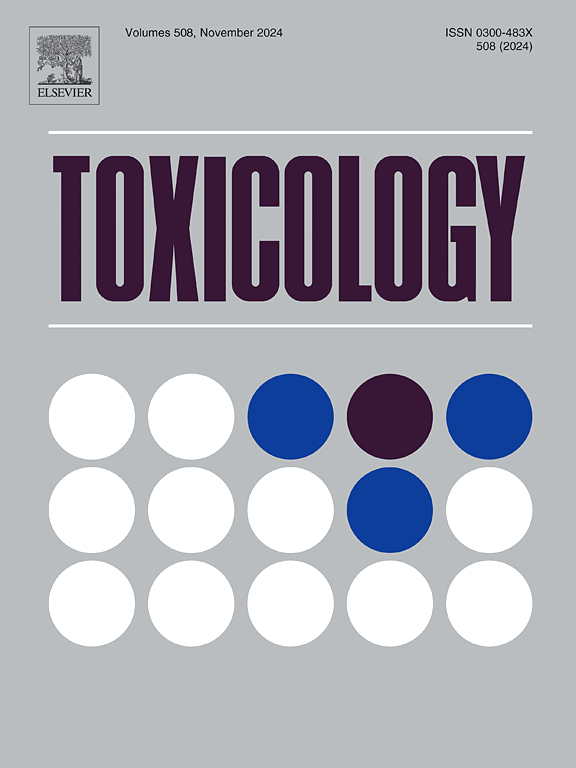两种纤维化途径:博莱霉素和TGFβ-1在肺成纤维细胞中的启动机制对比
IF 4.6
3区 医学
Q1 PHARMACOLOGY & PHARMACY
引用次数: 0
摘要
肺纤维化是一种进行性和衰弱性疾病,是一项重大的全球健康挑战。虽然通常是特发性的,但药物性纤维化正在增加其发病率。传统的化学品安全性评估依赖于体内模型的根尖端点,在捕捉引发纤维化的早期分子事件方面受到限制,因此限制了早期诊断和机制驱动治疗的潜力。本研究采用毒性基因组学方法对体外MRC-5成纤维细胞(一种参与纤维化的关键细胞类型)进行研究,剖析促纤维化刺激物博莱霉素(1,1.5,2 μg/mL)的促纤维化机制,并将其与TGFβ-1(5,10,15 ng/mL)进行比较,TGFβ-1是一种已知的24、48和72 小时的纤维化维持介质。我们的分析表明,虽然这两种药物都改变了基质相关的过程,但它们的启动机制不同。具体来说,tgf - β-1直接诱导肌成纤维细胞转化,而博莱霉素可能通过建立衰老相关分泌表型(SASP)间接诱导转化。通过捕获早期SASP特征,我们确定了博莱霉素诱导的成纤维细胞纤维化的关键驱动因素,与药物诱导的纤维化有关,其中抗肿瘤药物是主要关注的。这项研究强调了将机制理解纳入化学品安全评估的重要性,从而促进了更安全、更可持续的化学品发展的发展和实施。本文章由计算机程序翻译,如有差异,请以英文原文为准。
Two roads to fibrosis: Contrasting initiating mechanisms of Bleomycin and TGFβ-1 in lung fibroblasts
Pulmonary fibrosis, a progressive and debilitating disease, presents a significant global health challenge. Even though often idiopathic, drug-induced fibrosis is increasing its incidence. Traditional chemical safety assessments, relying on apical endpoints from in-vivo models, are limited in capturing the early molecular events initiating fibrosis, consequently limiting the potential for early diagnosis and mechanism-driven treatment. This study employed a toxicogenomic approach on in-vitro MRC-5 fibroblasts, a crucial cell type involved in fibrosis, to dissect the initiating profibrotic mechanisms of Bleomycin (1, 1.5, 2 μg/mL), a profibrotic triggering stimulus, comparing it with TGFβ-1(5, 10, 15 ng/mL), a known sustaining mediator of fibrosis over 24, 48, and 72 h. Our analysis reveals that while both agents alter matrix-related processes, their initiation mechanisms diverge. Specifically, TGFβ-1 directly induces myofibroblast transition, whereas Bleomycin potentially induces an indirect transition through the establishment of a senescence-associated secretory phenotype (SASP). By capturing the early SASP signature, we identified a critical driver of Bleomycin-induced fibroblast fibrosis, relevant to drug-induced fibrosis where antineoplastic agents are a major concern. This study underscores the critical importance of integrating mechanistic understanding into chemical safety assessment, thereby facilitating the development and implementation of safer, more sustainable chemical development.
求助全文
通过发布文献求助,成功后即可免费获取论文全文。
去求助
来源期刊

Toxicology
医学-毒理学
CiteScore
7.80
自引率
4.40%
发文量
222
审稿时长
23 days
期刊介绍:
Toxicology is an international, peer-reviewed journal that publishes only the highest quality original scientific research and critical reviews describing hypothesis-based investigations into mechanisms of toxicity associated with exposures to xenobiotic chemicals, particularly as it relates to human health. In this respect "mechanisms" is defined on both the macro (e.g. physiological, biological, kinetic, species, sex, etc.) and molecular (genomic, transcriptomic, metabolic, etc.) scale. Emphasis is placed on findings that identify novel hazards and that can be extrapolated to exposures and mechanisms that are relevant to estimating human risk. Toxicology also publishes brief communications, personal commentaries and opinion articles, as well as concise expert reviews on contemporary topics. All research and review articles published in Toxicology are subject to rigorous peer review. Authors are asked to contact the Editor-in-Chief prior to submitting review articles or commentaries for consideration for publication in Toxicology.
 求助内容:
求助内容: 应助结果提醒方式:
应助结果提醒方式:


